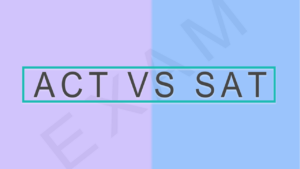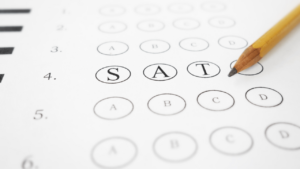Scholastic Aptitude Test, also known as SAT, is a reasoning test required by universities all across the globe for admission to undergraduate courses, mainly in the United States and the United Kingdom. The exam is scored out of a 1600 point score, with 400 being the minimum mark. The duration of the exam is 3 hours. SAT exams have an evidence-based reading and writing section along with a section dedicated to math, each being 800 marks. There is also an optional essay that takes 50 extra minutes. All the questions are multiple-choice questions (MCQs). The sections are in the order of Reading and Writing, Math, and then the optional essay. The test has no negative marking. Therefore, it is recommended to attempt all the questions. As SAT is a popular test, there are many candidates who opt for the same to increase their chances of scoring admission to the top prestigious universities. With the competition an individual is facing, they might wonder, ‘Is SAT difficultly?’ However, despite being a crucial exam known to influence undergraduate college admissions strongly, the SAT exam is not as difficult as it seems. It is all about considering all the factors, understanding the latest SAT exam 2022 format, and practising questions. Some of the top colleges and universities that accept SAT scores are Harvard University, Stanford, Yale, MIT, etc.
Table of Contents
In this article, we will examine the question ‘Is SAT difficult?’, understand the factors that contribute to the SAT difficulty level, and tips on how to make it easier.
Leap Advantage Virtual Spot Offer Event on May 10th 2024

Last call to secure your spot for Masters in STEM Program in the US for Fall ’24 exclusively for graduates and above.
Leap Advantage Virtual Spot Offer Event on May 10th 2024
Last call to secure your spot for Masters in STEM Program in the US for Fall ’24 exclusively for graduates and above.

Highlights of SAT Exam Difficulty Level
The SAT exam typically covers the concepts taught in the first two years of high school along with a few more advanced concepts. A candidate needs to wait about 14 days after the test to get the results for their SAT exam. The key to understanding how hard is the SAT is to understand the types of questions asked in the exam and become familiar with its structure.
1. Reading Section
The reading section includes an excerpt from an article, a book, or any other published material. This section tests the command of evidence, knowledge of words, and analysis in Social studies, History, and Science by examining the hypothesis and interpreting the data.
2. Writing Section
A passage will be provided in the writing section. The candidate has to proofread the same and correct the mistakes with the instructions provided in the question. This section tests the individual’s expression of ideas, punctuation, usage of words, and sentence structure.
3. Math Section
The questions in the Math section are a mix of multiple-choice and grid-in questions. The section is further divided into ‘with calculator’ and ‘no calculator’ sections. The section tests the conceptual understanding and applications of concepts of individuals, their fluency, and ease with topics such as algebra, linear equations and systems, data analysis and problem-solving, and geometry and trigonometry. About 50 per cent of the SAT score is accounted for in the Math section.
4. Optional Essay
The essay section in the SAT exam is optional as only some colleges require these essays. The components of the essay are scored from 2 to 8. These components include Writing, Analysis, and Reading. The purpose of the SAT Essay in the exam is to assess the ability of an individual to analyse the author’s argument; 50 additional minutes are provided for this optional section.
Factors that Contribute to the Difficulty of SAT
Some of the factors that can contribute to determining how difficult is SAT for Indian students are as discussed below —
Time Pressure
SAT test duration is for 3 hours. The test is timed, and therefore the time constraints can lead to some careless mistakes and test anxiety.
- In the reading section of SAT, one has to attempt 52 questions in 65 minutes, which is around 75 seconds per question without accounting for the time spent reading the passage. Hence, one should develop an efficient passage reading strategy.
- In the Writing section, there are 44 questions to be attempted in 35 minutes, that is about 48 seconds per question. The writing questions are also based on passages; hence, one needs to spend time reading in this section too.
- In the Math section, there are two subsections, one with a calculator and one without a calculator. In the ‘no calculator’ section, there are 20 questions in 25 minutes, and in the calculator section, there are 38 questions in 55 minutes. These account for 75 seconds per question and 87 seconds per question, respectively.
The strategies to tackle the issue of time pressure are:
- Attempting thoroughly timed practice tests to develop one’s pace
- Developing a habit of moving on with the next questions instead of being stuck on one question or hard questions for too much time. The student can return to those questions later to figure them out after completing the remaining test.
Challenge in Reading Passages
The SAT passages are excerpts from real published texts with at least one historical text. Therefore, the language of the same can be a little hard to comprehend as they are written at a fairly high level. A passage reading strategy and practise tests can help in the fast reading of the passages with full understanding. Some ways to tackle the reading questions are as follows:
- Working on vocabulary lists
- Reading short stories, speeches, and articles across different time periods.
Unfamiliar Math Concepts
The content of the SAT is most likely within the scope of what one has learnt in their high school math classes, especially algebra. However, some advanced concepts, which include basic trigonometry, are also included sometimes in the SAT test. This plays an important role in determining the question of ‘is SAT exam tough’. The word problems in the math section can also get a bit technical and wordy. It is a good idea to revisit the concepts learnt in high school and become familiar with some advanced concepts as per the exam pattern for math questions before the SAT test date.
High Levels of Stress
Colleges rely on these standardised test scores to judge prospective students, so it can seem like one’s whole future depends on these exams. This can lead to a high level of stress among individuals, leading to test anxiety and hampering one’s performance. Hence, how hard is SAT also depends on the mental state of an individual. Therefore, it is important to learn how to manage stress to make the exam more manageable. One needs to understand that they can take the test multiple times to submit the additional scores. The best way to tackle stress is by working on practice tests to enhance the level of preparation to get a good score.
Factors That Make the SAT Easier
There are also some factors that contribute to making SAT seem easier than other tests. Some of the factors that make it easier to crack the SAT exam are as given below —
No Penalty For Guessing
In the SAT, no points are deducted for wrong answers. One does not lose any points they have already earned. In case of confusion, candidates can just take a guess and fill an option rather than leaving a question blank. Even if the answer is wrong, one does not lose any marks; if the guess works out, one can secure additional marks.
No Memorisation
One does not need to learn or memorise the concepts to do well on the SAT. The SAT Math section provides the formulas required to solve the questions. The questions in the Writing and Reading sections are based on the passages and knowledge of basic grammar.
Almost All Questions are Multiple Choice
SAT is less labour-intensive than many tests in high school, as almost all the questions are multiple-choice questions. The answers are already given in the answer choices. The exceptions are the grid-in questions in the math sections (13 in total; 5 in the ‘no calculator’ section and 8 in the ‘with calculator’ section).
Predictable Structure & Type of Questions
The SAT sections are always arranged in the same order, which is:
- Reading
- Writing and Language
- Math – without a calculator
- Math – with calculator
The fundamental format of the SAT exam remains the same. This means that one can get familiar with it by practising tests before the test day. The practise tests will also acquaint you with the type of questions formed by the College Board as they do not change significantly from one test to the other.
Strategies to Make Taking the SAT Easier
Some tips on how to approach the SAT to make it more manageable are as given below —
Take Plenty of Practice Tests
The main reason SAT confuses and overwhelms students is that students are often unaware of the format of the test. With the time pressure, the format might confuse students and seem hard. A candidate should practice the official SAT practise test to be familiar with the content of the exam. One needs to get used to reading efficiently, maintaining speed, and staying calm throughout the test.
Examine & Correct Mistakes
With each practice test, one also needs to do further analysis. After the practice test, a candidate can go over what they missed and then figure out how to solve similar mistakes ahead. With each practice, the candidate can master the material until they have gone through all the concepts.
Use the Process of Elimination
There is a certain time constraint in the SAT exam. Rather than spending a lot of time on one question, one needs to look at them with a critical eye once. Try to sort out the questions and move ahead with the test, skipping questions if they seem too difficult. One can always come back to review those questions at the end of the exam.
Learn to Relax & De-stress
Taking the standardised test is easier if one avoids putting a lot of pressure on themselves throughout the process. Attempting the questions with a clear head can help you solve the exam and apply concepts efficiently.
Conclusion
Test-takers all around the world often question ‘Is SAT difficult?’. Is SAT hard or not mainly depends on the level of preparation of a candidate. It is generally a globally accepted exam with a complicated structure and a specific time duration dedicated to each section. A candidate can work on their reading ability by reading English excerpts from various sources. Candidates with a strong knowledge of English can have an advantage when taking the SAT. In SAT, the reading and writing section based on evidence and passages tests the verbal skills of a candidate. For the math section, the candidates can revise their high school concepts along with some advanced concepts of trigonometry. Knowing the application and theories of mathematical formulae can prove a significant advantage in the SAT, as almost 50 per cent of the score is dedicated to the Math section. SAT covers a wide syllabus, so along with preparing for the concepts, a candidate also needs to manage their time well to score good marks in the examination. The regular practice of SAT practice tests can help one identify the format of the questions and make their concepts strong. A good score on the SAT exam can help you get admission to top universities worldwide. LeapScholar can help you identify the top universities abroad for international students to pursue their undergraduate degree programs and guide you throughout the admission process.
Frequently Asked Questions
What are the types of SAT?
The SAT exam is of two types — SAT Test and SAT Subject Tests.
The SAT is a generalised test that evaluates the English, Mathematica, Verbal, and Scientific skills of candidates.
SAT subject tests, on the other hand, are taken to prove the knowledge of a candidate in a specific subject. The SAT subjects include English, Maths, Science, History, and Language.
One can look at the differences between SAT and SAT subject tests to understand which suits them the best per their needs. It should also be noted that the SAT subject test is no longer offered in the US, and only a few colleges require the SAT subject scores for admission. It is only available in May and June for international candidates.
What are the eligibility criteria for the SAT exam?
Candidates who want to give the SAT exam have to meet the following minor criteria:
Age Limit
There is no minimum or maximum age limit for a candidate to apply for the college SAT. Students who have cleared their high school can apply for the SAT. Generally, students in the age group of 17 to 19 are among the top test-takers for SAT.
Number of Attempts for the SAT Exam
There are no restrictions set by the College Board on the number of attempts for the SAT exam. A candidate can take the SAT exam as many times as they want. In India, generally, the SAT exam dates are available five times a year, usually in the months of March, May, August, October, and December.
Educational Eligibility Criteria
SAT exams can be taken by students in high school who want to apply for undergraduate studies abroad.
ID Proof
SAT eligibility criteria require individuals to have a valid Aadhaar card or passport. The same should contain their name, photograph, and signature. The document should not be worn, torn, or damaged in any way.
What is the SAT cutoff required by the top universities abroad?
Some of the top colleges and their SAT cutoff for international students are as follows:
Princeton UniversityMath Section – 740 to 800
Evidence-Based Reading and Writing Section (EBRW) – 710 to 800
Yale UniversitySAT Math – 740 to 790
SAT Evidence-Based Reading and Writing (EBRW) – 720 to 770
Massachusetts Institute of TechnologyMath – 790
Evidence Based Reading and Writing (EBRW) – 730 to 780
Dartmouth CollegeSAT Math – 770
SAT Critical Reading Evidence-Based Reading and Writing (EBRW) – 750
Stanford UniversityMath Section – 770
Evidence Based Reading and Writing (EBRW) – 735
Composite Score – 1505







